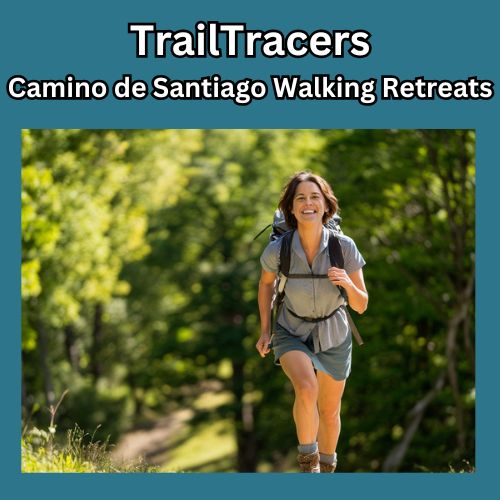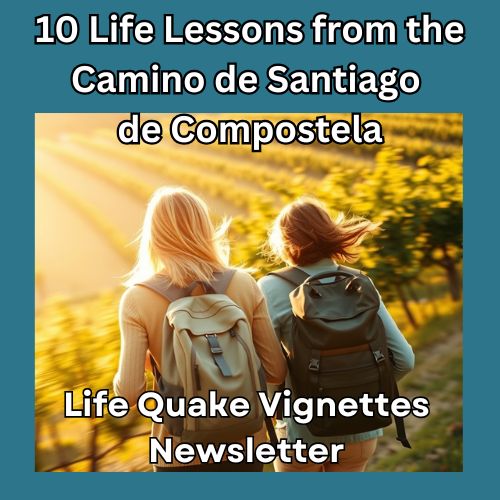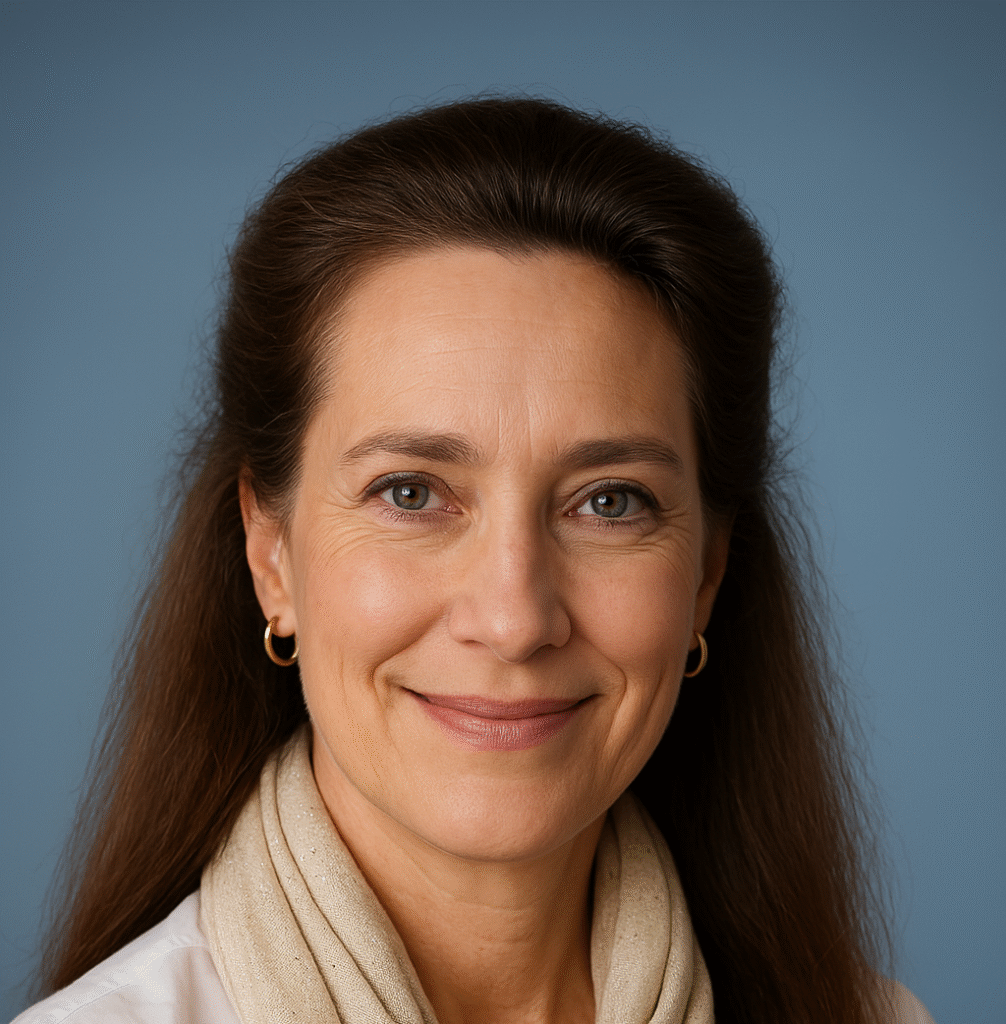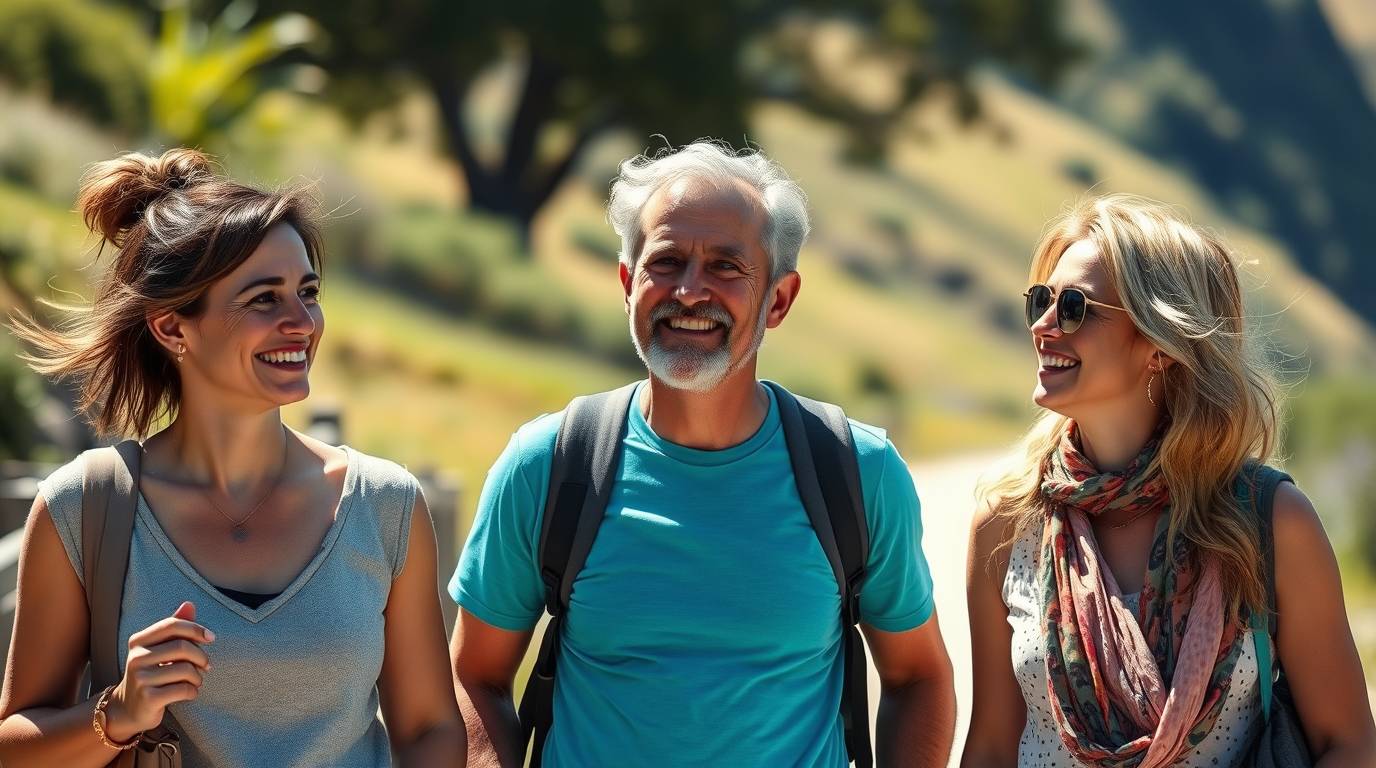How an Ancient Pilgrimage Trail can Reveal Your True Direction in Life
The morning mist clings to the rolling hills of Gascony like whispered secrets, and Sarah’s boots crunch against the frost-touched grass as she takes her first steps on the ancient pilgrimage route. She doesn’t know it yet, but this moment—10:47 AM on a Tuesday in October—will become the dividing line between who she was and who she’s meant to become.
Sarah, a 42-year-old marketing executive from London, arrived at my retreat centre a day ago carrying more than just her carefully packed rucksack. She brought the weight of a career that felt increasingly hollow, a marriage that had calcified into polite routine, and a persistent question that haunted her quiet moments: “Is this all there is?”
She’s not alone. In the years I’ve been guiding week-long nature retreats along the Chemin de Saint-Jacques in southwest France, I’ve witnessed hundreds of souls arrive at this same crossroads. They come from corporate boardrooms and suburban kitchens, from hospital corridors and university lecture halls, all carrying variations of the same silent plea: show me how to live the next decade of my life with intention.
The Ancient Path as Mirror
The Camino de Santiago has been calling to seekers for over a thousand years, but this particular stretch through Gascony and the Pyrenean foothills offers something unique. Away from the more travelled Spanish routes, these paths wind through landscapes that seem untouched by the urgency of modern life. Here, time moves differently. Here, the soul has space to breathe.
Sarah’s second day’s walking begins before dawn, not because I demand it, but because something in the pre-dawn silence draws her outside. The air smells of oak leaves and wood smoke from distant farmhouses. Her breath creates small clouds that dissipate quickly in the cool air, and for the first time in months, she notices she’s not thinking about her phone, her emails, or the presentation that’s due next Monday.
“I keep waiting for the anxiety to hit,” she tells me as we pause beside a stone fountain that has served pilgrims since the 12th century. “But it’s like someone turned down the volume on all the noise in my head.”
This is the first lesson the Camino offers: clarity comes not from adding more to our lives, but from stripping away everything that isn’t essential. In our hyperconnected world, we’ve forgotten the profound wisdom of simplicity. When your world shrinks to the weight of your pack, the feel of the path beneath your feet, and the rhythm of your breath, perspective shifts dramatically.
The Stories That Transform Us
By the third day, Sarah walks alongside Miguel, a 38-year-old architect from Barcelona who left his job six months ago after what he calls his “glass ceiling revelation.” Not a promotion denied, but the sudden understanding that even achieving everything he thought he wanted would leave him fundamentally unfulfilled.
“I was designing buildings I’d never want to live in, for developers who only saw profit margins,” Miguel shares as they navigate a particularly steep section through a chestnut forest. The trees tower above them, their leaves creating a golden canopy that filters the morning light into dancing patterns on the forest floor. “I realised I was spending my days creating structures without soul.”
Their conversation unfolds naturally, the way meaningful exchanges do when you’re walking side by side rather than facing each other across a table. There’s something about forward movement that encourages honest reflection. The path becomes a confessional, a therapy session, a laboratory for examining life choices.
This is where the true magic of a week in nature reveals itself. Stripped of our usual roles and distractions, we begin to see ourselves clearly. The executive becomes simply a person who needs to rest when tired, eat when hungry, and find shelter when it rains. The architect remembers that he once dreamed of designing homes that would nurture families, not maximise square footage per euro.
The Wisdom of Weather
On the fourth day, rain arrives with the sudden intensity that October can bring to this region. It’s not the gentle drizzle that many expect when they picture a pilgrim walking—it’s a proper downpour that turns the earth to mud and tests the waterproofing of even the most expensive gear.
Sarah and Miguel huddle with three other walkers under the stone overhang of a medieval bridge, watching the river below swell with fresh rainwater. This is exactly the moment when many people would pull out phones, check weather apps, calculate alternative routes, or simply complain about the inconvenience.
Instead, something remarkable happens. Elena, a 51-year-old nurse from Toulouse who joined the retreat during a sabbatical year, begins to laugh. Not the bitter laugh of frustration, but genuine delight.
“Do you know how long it’s been since I just watched rain fall without thinking about anything else?” she asks, her eyes bright with an almost childlike wonder. “We’re so busy controlling everything that we forget how good it feels to just… be present with what is.”
The rain becomes a teacher. It shows them that some things cannot be rushed, controlled, or optimised. Sometimes the best response to challenging conditions is not resistance but acceptance, patience, and finding joy in unexpected places. This lesson will serve them well in the decades ahead, when life inevitably delivers its own storms.
The Rhythm of Renewal
By the fifth day, something fundamental has shifted in the group dynamic. The conversations deepen. Sarah talks about her marriage with a tenderness that surprises her—she realises she’s been fighting the wrong battles, trying to change her husband instead of examining what she truly needs to feel fulfilled. Miguel sketches building designs in his journal during rest breaks, but now they’re small homes with gardens, community spaces that prioritise gathering over grandeur.
Elena has started carrying a small notebook where she records moments of beauty: the way morning light strikes a particular hillside, the sound of church bells drifting across a valley, the taste of bread bought warm from a village bakery. She’s documenting joy with the same precision she once reserved for medical charts.
“I’m not trying to solve my life out here,” Sarah explains as we navigate a section of path lined with ancient stone walls. “I’m trying to remember what my life actually feels like when I’m not rushing through it.”
This is perhaps the most profound shift that occurs during these retreats. People stop treating their lives like problems to be solved and start experiencing them as stories to be lived. The difference is transformative.
The Village That Teaches Community
One day, they reach the village of Laressingle, often called the smallest fortified city in France. Its medieval walls enclose just a handful of buildings, but the village has maintained its essential character across centuries. The local café serves the same simple meal it has for decades—cassoulet, local bread, and wine from vineyards that have been in the same families for generations.
Miguel strikes up a conversation with the café owner in broken French supplemented with enthusiastic gestures. The man’s grandfather walked portions of the Camino as a young man, carrying messages between villages during the war. Stories layer upon stories, and suddenly the path they’re walking becomes part of a much larger narrative.
“This is what I want,” Sarah says quietly, watching the easy interaction between the retreat participants and the villagers. “Not this specific place, but this sense of belonging to something larger than myself.”
The village teaches them about sustainability—not the buzzword version that fills corporate mission statements, but the lived reality of communities that have thrived for centuries by understanding their place within larger cycles. These people know which foods grow well in local soil, how to read weather patterns, and how to maintain traditions while adapting to changing times.
The Summit of Understanding
The final walking day brings the group to a modest summit overlooking the Pyrenees. It’s not a dramatic peak—the highest point of their journey reaches only about 600 meters—but the view encompasses the entire landscape they’ve traversed over the past week. They can see the path snaking through valleys, the villages where they’ve shared meals, the forests where they’ve found shelter.
Elena spreads out her worn map and traces their route with her finger. “Look how far we’ve come,” she marvels. “And look how much we couldn’t see from where we started.”
This becomes the metaphor that will guide them through the next decade. Life rarely reveals its full pattern while you’re living it day by day. The significance of decisions, relationships, and changes often only becomes clear when viewed from a distance. But the walking has taught them to trust the process, to find meaning in the daily steps rather than demanding to see the entire route at once.
Sarah pulls out her phone for the first time in days, not to check messages, but to photograph the view. As she does, she notices something: she has seventeen missed calls from her office, forty-three unread emails, and a text thread with her husband that spans several days of increasingly worried messages.
Instead of panic, she feels a curious calm. The urgency that once drove her daily decisions seems artificial from this vantage point. The missed calls represent problems that others solved in her absence. The emails mostly concern meetings about meetings. Her husband’s messages, read in sequence, show his progression from annoyance to concern to something approaching admiration for her commitment to this journey.
The Return and the Real Beginning
The retreat officially ends on the seventh day, but the real transformation begins when participants return to their ordinary lives. Sarah boards the train back to London carrying the same belongings she brought, but everything has changed. The clothes smell of wood smoke and morning air. Her boots carry dust from ancient paths. Her journal is filled with observations that will take months to fully understand.
Miguel returns to Barcelona with sketches for buildings that prioritise human connection over maximum profit margins. He’s already scheduled meetings with developers who share his vision for architecture that serves communities rather than just consuming space.
Elena extends her sabbatical by three months and signs up for a permaculture course in the Dordogne. She’s discovered that her skills as a nurse translate perfectly to tending growing things, and she’s exploring how to combine healthcare with environmental healing.
But the most significant changes are often the subtle ones. Sarah finds herself walking to work instead of taking the tube, choosing routes that pass through parks rather than staying on busy streets. She starts her mornings ten minutes earlier, not to answer emails, but to sit quietly with coffee and notice how light changes throughout the seasons.
Miguel begins each design project by visiting the location at different times of day, in different weather, listening to how the space wants to be used rather than imposing predetermined ideas. His clients initially find this approach unusual, but the buildings that result have a quality of aliveness that sets them apart.
Elena returns to nursing with renewed purpose, but she brings practices from the retreat into her work. She notices which patients respond to stories about the natural world. She advocates for hospital gardens and walking programs. She prescribes time outdoors with the same confidence she once reserved for medications.
The Ten-Year Vision
What does a week in nature teach about the next decade? The lessons are both practical and profound.
First, it reveals the difference between being busy and being purposeful. Modern life encourages constant activity, but the Camino teaches the value of sustainable rhythm. Sarah learns to structure her work weeks around energy cycles rather than arbitrary deadlines. Miguel discovers that his best design ideas come during walking breaks, not extended desk sessions. Elena finds that she can serve her patients more effectively when she maintains her own connection to sources of renewal.
Second, it demonstrates the power of incremental progress. Walking twenty kilometers per day doesn’t feel particularly heroic in any single moment, but over a week, it transforms both landscape and perspective. This becomes their approach to major life changes—small, consistent steps rather than dramatic gestures.
Third, it shows how much wisdom emerges from simply paying attention. Without the distraction of constant connectivity, retreat participants begin to notice patterns in their thoughts, relationships, and desires that were previously invisible. Sarah realises she’s been solving the wrong problems in her marriage. Miguel sees that his creativity flows when he aligns with natural rhythms rather than fighting them. Elena discovers that her caregiving impulse extends far beyond her professional role.
The Ripple Effect
Perhaps most importantly, the Nature Immersion Camino walking retreat teaches that personal transformation inevitably affects others. Sarah’s newfound clarity helps her have conversations with her husband that they’ve been avoiding for years. Instead of criticising his habits, she shares her own discoveries about what brings her alive. The shift in her approach creates space for him to examine his own assumptions about success and fulfilment.
Miguel’s commitment to meaningful architecture attracts clients who share his values. His projects become gathering places for communities that prioritise connection over consumption. The buildings he designs today will influence how people live and relate to each other for generations.
Elena’s integration of nature-based practices into healthcare introduces hundreds of patients to approaches they might never have encountered otherwise. Her stories about the retreat inspire colleagues to consider their own relationships with the natural world. The hospital where she works begins to incorporate outdoor spaces into treatment protocols.
The Soul’s Reboot
This is what we mean by calling the retreat a “reboot for the soul.” In technology, a reboot clears temporary files, closes unnecessary programs, and returns a system to its optimal functioning state. A week in nature does something similar for human consciousness.
It clears the accumulation of other people’s urgencies that masquerade as our own priorities. It closes the mental programs that run constantly in the background—the comparative thinking, the future worrying, the past analysing—and returns us to the simple clarity of present-moment awareness.
But unlike a technological reboot, which simply returns to previous settings, this process reveals new possibilities. When Sarah stops running default programs about career success and social expectations, she discovers desires and capacities she’d forgotten she possessed. When Miguel steps away from the competitive mindset that dominated his professional life, he finds creative approaches that serve both his artistic vision and his community’s needs.
The Continuing Trail
The retreat ends, but the path continues. Sarah, Miguel, and Elena maintain contact, sharing updates about how retreat insights unfold in their daily lives. They’ve learned that transformation isn’t a destination but an ongoing process of alignment—continuously adjusting course based on what they discover about themselves and what the world needs from them.
A year later, Sarah has negotiated a four-day work week that allows her to spend Fridays hiking in the countryside outside London. Her marriage has deepened through honest conversations about what they each need to feel alive and connected. She’s begun leading weekend walking groups for other corporate professionals who are questioning the sustainability of their current paths.
Miguel has opened a small architecture practice focused on affordable housing that incorporates permaculture principles. His projects are smaller in scale but larger in impact, creating living spaces that help residents connect with both community and natural cycles. He returns to the French countryside every autumn, walking the eact same sections of the Camino, in different seasons, to maintain his connection to the insights that redirected his career.
Elena has completed training in ecotherapy and now offers healing programs that combine traditional healthcare with time in natural settings. She’s discovered that many physical ailments respond remarkably well to treatments that address the whole person within their environmental context. Her approach is gaining recognition in progressive medical circles, and she’s been invited to develop protocols for other healthcare systems.
Your Invitation
Their stories illustrate a fundamental truth that a week in nature makes unmistakably clear: we are not separate from the natural world, and our well-being is intimately connected to the health of the systems that sustain all life. When we slow down enough to remember this connection, we begin making decisions that serve not just our immediate wants but our deepest needs and the needs of the larger community.
This understanding becomes the foundation for navigating the next decade with wisdom rather than just ambition. Instead of asking “How can I get more?” we learn to ask “How can I contribute?” Instead of seeking to control outcomes, we develop the capacity to respond creatively to whatever emerges.
The trail through southwest France continues to call to new seekers each season. The ancient stones witness new stories of transformation. The villages continue to offer refuge and a reminder that humans have always found ways to live in harmony with the land that sustains them.
The question is not whether you need this kind of deep renewal—the modern world ensures that almost everyone does. The question is whether you’re ready to step onto the path that leads not just through beautiful landscapes, but toward the life you’re actually meant to live.
The trail begins with a single step. The transformation unfolds one day at a time. And the next ten years of your life are waiting to be discovered, one footprint after another, along paths that have been guiding seekers toward their true selves for a thousand years.
The invitation is always there. The trail is always waiting. The only question is: when will you take that first step into the rest of your life?

If your soul is craving fresh air, meaningful movement, and a chance to reconnect with nature, join us on a Camino de Santiago Crossroads Retreat in the southwest of France. This isn’t just a scenic hike – it’s a powerful, natural reboot for your body, mind, and spirit. Imagine quiet paths, rolling hills, cozy evenings, and slow conversations. No fitness requirements. No forced bonding. No pressure to have a breakthrough. Just one foot in front of the other, and a journey that meets you exactly where you are.

10 Powerful Life Lessons Learned While Walking the Camino de Santiago – a free guide filled with 10 not just “quaint anecdotes” or Instagram-worthy moments (though there are plenty of those) but real transformations from real people who walked the same insight-giving trail you might want to walk one day – Subscribe to my monthly newsletter to Download the Guide

“I am an experienced medical doctor – MBChB, MRCGP, NLP master pract cert, Transformational Life Coach (dip.) Life Story Coach (cert.) Stress Counselling (cert.) Med Hypnotherapy (dip.) and EAGALA (cert.) I may have an impressive number of letters after my name, and more than three decades of professional experience, but what qualifies me to excel at what I do is my intuitive understanding of my clients’ difficulties and my extensive personal experience of managing major life changes using strategies I developed over many years.” Dr M Montagu

